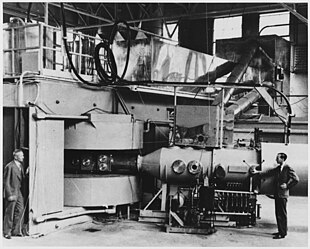Physics
Willis Lamb
Robert Andrews Millikan
Deuterium
Deuterium (or hydrogen-2, symbol D or 2H, also known as heavy hydrogen) is one of two stable isotopes of hydrogen (the other being protium, or hydrogen-1). The nucleus of deuterium, called a deuteron, contains one proton and one neutron, whereas the far more common protium has no neutron in the nucleus. Deuterium has a natural abundance in Earth’s oceans of about one atom in 6420 of hydrogen. Thus deuterium accounts for approximately 0.0156% (or, on a mass basis, 0.0312%) of all the naturally occurring hydrogen in the oceans, while protium accounts for more than 99.98%. The abundance of deuterium changes slightly from one kind of natural water to another (see Vienna Standard Mean Ocean Water).
https://en.wikipedia.org/wiki/Deuterium
Oppenheimer–Phillips process
The Oppenheimer–Phillips process or strip reaction is a type of deuteron-induced nuclear reaction. In this process the neutron half of an energetic deuteron (a stable isotope of hydrogen with one proton and one neutron) fuses with a target nucleus, transmuting the target to a heavier isotope while ejecting a proton. An example is the nuclear transmutation of carbon-12 to carbon-13.
The process allows a nuclear interaction to take place at lower energies than would be expected from a simple calculation of the Coulomb barrier between a deuteron and a target nucleus. This is because, as the deuteron approaches the positively charged target nucleus, it experiences a charge polarization where the “proton-end” faces away from the target and the “neutron-end” faces towards the target. The fusion proceeds when the binding energy of the neutron and the target nucleus exceeds the binding energy of the deuteron and a proton is then repelled from the new, heavier, nucleus
https://en.wikipedia.org/wiki/Oppenheimer%E2%80%93Phillips_process
Frank Oppenheimer
Melba Phillips
Melba Newell Phillips (February 1, 1907 – November 8, 2004) was an American physicist and pioneer science educator. One of the first doctoral students of J. Robert Oppenheimer at the University of California, Berkeley, Phillips completed her Ph.D. in 1933, a time when few women pursued careers in science. In 1935 Oppenheimer and Phillips published[1] their description of the Oppenheimer-Phillips effect, an early contribution to nuclear physics that explained the behavior of accelerated nuclei of radioactive hydrogen atoms. Phillips was also known for refusing to cooperate with a U.S. Senate judiciary subcommittee’s investigation on internal security during the McCarthy era that led to her dismissal from her professorship at Brooklyn College, where she was a professor of science from 1938 until 1952. (The college publicly and personally apologized to Phillips for the dismissal in 1987.)
https://en.wikipedia.org/wiki/Melba_Phillips
Cyclotron
A cyclotron is a type of particle accelerator invented by Ernest O. Lawrence in 1929-1930 at the University of California, Berkeley, and patented in 1932. A cyclotron accelerates charged particles outwards from the center along a spiral path. The particles are held to a spiral trajectory by a static magnetic field and accelerated by a rapidly varying (radio frequency) electric field. Ernest O. Lawrence was awarded the 1939 Nobel prize in physicsfor this invention.
Cyclotrons were the most powerful particle accelerator technology until the 1950s when they were superseded by the synchrotron, and are still used to produce particle beams in physics and nuclear medicine. The largest single-magnet cyclotron was the 4.67 m (184 in) synchrocyclotron built between 1940 and 1946 by Lawrence at the University of California at Berkeley, which could accelerate protons to 730 million electron volts (MeV). The largest cyclotron is the 17.1 m (56 ft) multimagnet TRIUMF accelerator at the University of British Columbia in Vancouver, British Columbia which can produce 500 MeV protons.
Over 1200 cyclotrons are used in nuclear medicine worldwide for the production of radionuclides.
Ernest Walton
Ernest Thomas Sinton Walton (6 October 1903 – 25 June 1995) was an Irish physicist and Nobel laureate for his work with John Cockcroft with “atom-smashing” experiments done at Cambridge University in the early 1930s, and so became the first person in history to artificially split the atom.
https://en.wikipedia.org/wiki/Ernest_Walton
John Cockcroft
Ernest Lawrence
Felix Bloch – Wikipedia
Felix Bloch (23 October 1905 – 10 September 1983) was a Swiss physicist, working mainly in the U.S.[1] He and Edward Mills Purcell were awarded the 1952 Nobel Prize for Physics for “their development of new ways and methods for nuclear magnetic precision measurements.”[2] In 1954–1955, he served for one year as the first Director-General of CERN. Felix Bloch made fundamental theoretical contributions to the understanding of electron behavior in crystal lattices, ferromagnetism, and nuclear magnetic resonance.
https://en.wikipedia.org/wiki/Felix_Bloch

